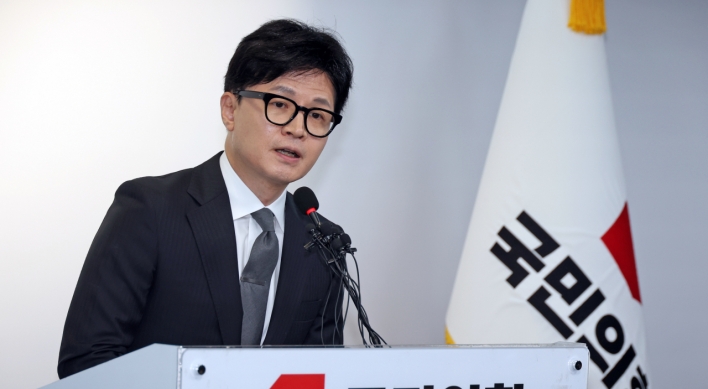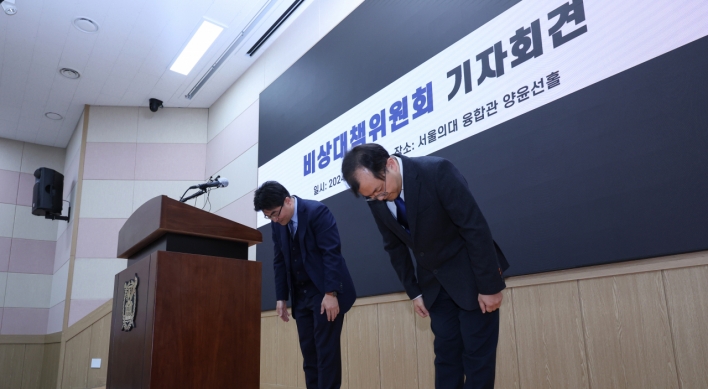
NEW YORK (AFP) ― The brutal aftermath of the once euphoric Egyptian revolution is on stark display in a powerful New York exhibition that lays bare grief, death and shattered hopes.
Three years after protests first erupted across the Arab world, ultimately deposing autocratic rulers in Tunisia, Egypt, Libya and Yemen, the hopes of millions now lie stagnant or in tatters.
In Egypt, Iranian-American artist Shirin Neshat witnessed firsthand the evolution as she traveled between New York and Cairo making a film about the legendary singer Umm Kulthum.
In early 2011, Neshat was swept up in the uprising that saw millions take to the streets to force out Egyptian president Hosni Mubarak after three decades in power.
Hopes of a democratic dawn led to elections but after the Muslim Brotherhood’s Mohamed Morsi took office as president, an increasingly polarized Egypt staggered from crisis to crisis.
By the time she returned in November 2012, the month of Morsi’s power grab that sparked bloody protests and ultimately led to his own sacking, Neshat found that hopes had soured.
“Already, things were going the wrong way,” she told AFP ahead of the opening of her new exhibition, “Our House is on Fire,” which officially opens on Friday, running until March 1.
She sought out and photographed elderly Egyptians ― street sellers, teachers and housewives ― whose faces are etched with the depth of poverty and tragedy so many have endured.
“When you’re confronted with them, I hope it moves people ... the art world seems so distant from this sort of reality,” the elegant, diminutive artist said.
Her subjects came one by one to a small studio near Tahrir Square, the hub of the uprising, and exchanged stories.
As their photographs were taken, she asked each to think about one moment of tragedy.
“And before you know it, a lot of them started crying, then there was a lot of hugging,” said Neshat. “A few of the women had lost children, they started sobbing and then they calmed down.
“These people have suffered a lot and I think in many ways, their expressions went beyond this one thing,” she said.
Upon her return to New York, Neshat shot photographs of feet, taken to resemble the images that struck her most from morgues in Egypt: bodies with identity tags hanging from their toes.
Painted over some of the photographs are calligraphy of verses by Iranian poets Mehdi Akhavan Sales and Forough Farrokhzad about their country under the siege and the loss of a loved one.
The launch party was an eclectic crowd, a lively mix of luminaries from the art world, Iranian emigres, artists and photographers, and aficionados of photography and the Middle East.
Neshat previously photographed youth inspired by the Arab Spring and this exhibition, on show at the Robert Rauschenberg Foundation in the Chelsea gallery district, bookends her experiences.
Three years after protests first erupted across the Arab world, ultimately deposing autocratic rulers in Tunisia, Egypt, Libya and Yemen, the hopes of millions now lie stagnant or in tatters.
In Egypt, Iranian-American artist Shirin Neshat witnessed firsthand the evolution as she traveled between New York and Cairo making a film about the legendary singer Umm Kulthum.
In early 2011, Neshat was swept up in the uprising that saw millions take to the streets to force out Egyptian president Hosni Mubarak after three decades in power.
Hopes of a democratic dawn led to elections but after the Muslim Brotherhood’s Mohamed Morsi took office as president, an increasingly polarized Egypt staggered from crisis to crisis.
By the time she returned in November 2012, the month of Morsi’s power grab that sparked bloody protests and ultimately led to his own sacking, Neshat found that hopes had soured.
“Already, things were going the wrong way,” she told AFP ahead of the opening of her new exhibition, “Our House is on Fire,” which officially opens on Friday, running until March 1.
She sought out and photographed elderly Egyptians ― street sellers, teachers and housewives ― whose faces are etched with the depth of poverty and tragedy so many have endured.
“When you’re confronted with them, I hope it moves people ... the art world seems so distant from this sort of reality,” the elegant, diminutive artist said.
Her subjects came one by one to a small studio near Tahrir Square, the hub of the uprising, and exchanged stories.
As their photographs were taken, she asked each to think about one moment of tragedy.
“And before you know it, a lot of them started crying, then there was a lot of hugging,” said Neshat. “A few of the women had lost children, they started sobbing and then they calmed down.
“These people have suffered a lot and I think in many ways, their expressions went beyond this one thing,” she said.
Upon her return to New York, Neshat shot photographs of feet, taken to resemble the images that struck her most from morgues in Egypt: bodies with identity tags hanging from their toes.
Painted over some of the photographs are calligraphy of verses by Iranian poets Mehdi Akhavan Sales and Forough Farrokhzad about their country under the siege and the loss of a loved one.
The launch party was an eclectic crowd, a lively mix of luminaries from the art world, Iranian emigres, artists and photographers, and aficionados of photography and the Middle East.
Neshat previously photographed youth inspired by the Arab Spring and this exhibition, on show at the Robert Rauschenberg Foundation in the Chelsea gallery district, bookends her experiences.
-
Articles by Korea Herald


![[Exclusive] Korean military set to ban iPhones over 'security' concerns](http://res.heraldm.com/phpwas/restmb_idxmake.php?idx=644&simg=/content/image/2024/04/23/20240423050599_0.jpg&u=20240423183955)

![[Graphic News] 77% of young Koreans still financially dependent](http://res.heraldm.com/phpwas/restmb_idxmake.php?idx=644&simg=/content/image/2024/04/22/20240422050762_0.gif&u=)




![[Pressure points] Leggings in public: Fashion statement or social faux pas?](http://res.heraldm.com/phpwas/restmb_idxmake.php?idx=644&simg=/content/image/2024/04/23/20240423050669_0.jpg&u=)









